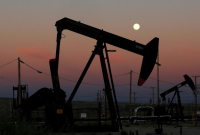Support strong Canadian climate journalism for 2025
Imagine producing a bumper crop of a product in high demand around the globe, only to learn you must settle for a discounted price because there's no easy way to get your product to market.
Canadian grain farmers experienced that situation in 2013 and again last winter when their harvest outstripped the transport capacity of Canada's rail companies. Western Canada's oil companies are now in the same boat thanks to production gains that have not been matched by export pipeline capacity gains.
Like those farmers, oil producers have filled storage to bursting while they wait for a solution to appear. The price discounts or "differentials" that had mainly affected heavy oil have spread to light oil and upgraded synthetic oilsands crude as pipeline space tightens.
Estimates on the cost to the economy vary wildly, but the Canadian Association of Petroleum Producers officially estimates the impact as at least C$13 billion in the first 10 months of 2018.
It estimates the cost at about C$50 million per day in October as discounts for Western Canadian Select bitumen-blend crude oil versus New York-traded West Texas Intermediate peaked at more than US$52 per barrel.
"The differential has blown out to such an extreme level for two reasons, the lack of access to markets and the fact we really have only one customer (the United States)," said Tim McMillan, CEO of CAPP.
Getting an exact number on how much discounts are costing Canada is all but impossible thanks to ingrained sector secrecy about transportation and marketing, he said, adding it's entirely possible the real costs could be as high as $100 billion per year.
Producers' exposure to WCS prices differ depending on what kind of oil they produce, where they sell it and how they transport it.
Calgary-based Imperial Oil Ltd., for instance, says about one-quarter of its output of 300,000 barrels of bitumen per day is influenced by WCS pricing — the rest is used in its Canadian refineries or shipped by pipe or rail to the U.S. Gulf Coast where it gets close to WTI prices.
The company announced last week it will build a 75,000-bpd oilsands project, going on faith that pipelines will be in place for when production begins in about four years (a prospect that took a hit Thursday when a U.S. judge put TransCanada Corp.'s Keystone XL pipeline on hold until more environmental study is done).
Meanwhile, it is ramping up rail shipments from its co-owned Edmonton terminal as fast as it can.
Other oilsands producers including Canadian Natural Resources Ltd. and Cenovus Energy Inc. are cutting production to avoid selling at current prices.
The industry's problems receive little sympathy from environmentalists like Keith Stewart of Greenpeace.
"The root of the problem is that companies kept expanding production even when they knew there was no new transport," he said.
But McMillan pointed out it takes years to plan, win regulatory approval and build projects.
For example, producers would have had no way of knowing ahead of time that the 525,000-barrel-per-day Northern Gateway pipeline project approved in 2014 by a Conservative government would then be rejected by a Liberal government in 2016, he said.
"If Northern Gateway had come on as planned, we wouldn't be in this situation," said McMillan.
In a report last February, Scotiabank analysts estimated the differential would shave C$15.6 billion in revenue annually, with a quick ramp up in crude-by-rail expected to shrink the hit to C$10.8 billion by the fall.
At that time, discounts had widened to about US$30 per barrel from an average of around US$13 in the previous two years.
Crude-by-rail shipments increased to a record 230,000 bpd in August but haven't reduced the differential.
According to Calgary-based Net Energy, the WCS-WTI differential averaged US$45.48 per barrel in October and has averaged US$43.75 so far in November.
In an analysis last March, Kent Fellows, research associate at the School of Public Policy at the University of Calgary, estimated the differential would translate into a $13-billion economic loss if it persisted for a year — $7.2 billion to the Alberta government, $5.3 billion to industry and $800 million to the federal government.
The differential has gotten much worse, he said in an interview this week, which means the lost opportunity is proportionately worse.
Higher differentials hit provincial governments in the form of lower-than-expected royalties — their cut of every barrel produced from land where mineral rights are Crown owned — while the federal government will see lower corporate income taxes, Fellows said.
"If this keeps up and we start to see either a lack of growth or more shutting in some of this production ... you're losing jobs and even personal income tax as well," he said.
The Alberta government estimates that every annual average $1 increase in the WCS-WTI differential above US$22.40 per barrel costs its treasury C$210 million.
In Saskatchewan, Western Canada's other major oil-producing province, each $1 change in the differential is equivalent to about $15 million in revenue, based on an assumed WTI price of US$58 per barrel, the government says.
Finance Minister Donna Harpauer said in an interview that if current discounts continued for a year, the Saskatchewan industry's lost revenue would be about C$7.4 billion.
Part of the reason WCS discounts were wider in October is that WTI, which opened the year at US$60.37 per barrel, jumped to more than US$76. Producers exposed to WCS didn't get the benefit of the higher U.S. oil prices.
McMillan said the differentials are being noticed by potential energy investors — CAPP expects capital investment of $42 billion in the Canadian oilpatch in 2018, down from $81 billion in 2014.
"We're losing hundreds of millions of dollars that's going to subsidize drivers in the United States."





Comments
Imagine having 12 years to keep the planet at a habitable temperature (by stopping the production and burning of fossil fuels), and worrying about how to get yet more of it to market!
What about how to get the country onto renewable, clean energy instead?
I just read an article published in Energy Mix stating that Cenovus, Suncor, CNRL, Husky, and Imperial (Alberta's tar sands biggies) were very profitable in 2017. They sent $4.16 billion to shareholders, bought back $2.04 billion of shares, put away $7.3 billion in savings, and remitted $4.72 billion to governments in taxes and royalties. So where is the problem? That $7.3 billion should be put to use - start cleaning up that $260 billion liability (environmental disaster).
Hmmm. so the “producing entity” (paying royalties in the producing area) sells at a discount to the refining entity (of the same company) who realizes a windfall gain! How convenient. So at least the money isn’t “lost”. Better yet- it could be forwarded to an organizing entity (of yes the same corporation - likely registered in the Cayman Islands) to avoid paying all taxation before “forwarding” the shipment to the refinery - unless it is ALREADY doing this now. Ahhhh - The wonders of transfer pricing in the global economy!
The shortage of overseas export capacity is a myth propagated by the oil industry. Trans Mountain has a tanker terminal in Burnaby, British Columbia and uses it to export oil. As I write there is no tanker there, and none anywhere near it. This terminal can load a large Aframax tanker in about two days, a rate of about 150 per year. The smaller Panamax tankers take just over a day to load, a rate of about 300 per year. 15 tankers were loaded in 2016, and 18 were loaded in 2017. This year the number is likely to be 45. Thus, there is and has been much unused capacity to export oil overseas.
Anyone interested in the details should ask me at huntley{at}sfu{dot}ca.
I'm shocked David. Why triple the capacity of the Trans Mountain pipeline when the current pipeline is underutilized? by as much as 60% to 90%. Albertans are screaming for additional pipeline capacity but they're not using the existing capacity.
Why is National Observer publishing an article that promotes the oil industry, when we know we have to cut carbon emissions quickly to keep the Earth habitable? I am disappointed.